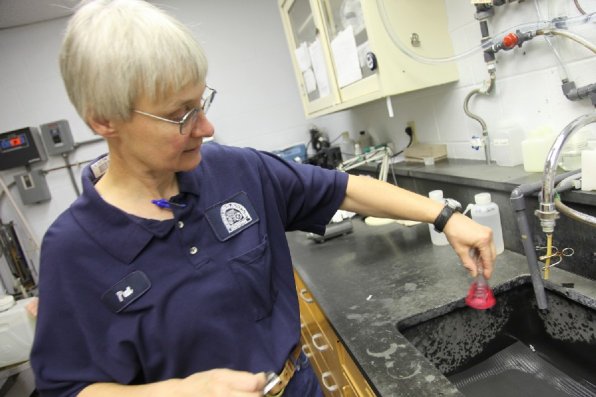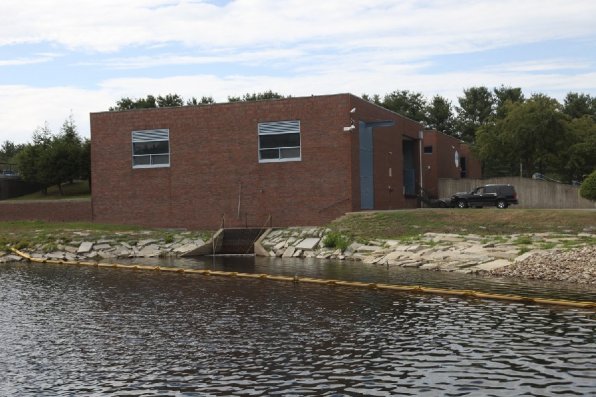When the city’s 2010 water quality report arrived in the mailbox last month, our water wheels got to spinning. We realized that we knew only two things for sure about Concord’s water supply: Its source is Penacook Lake in West Concord, and it runs through a faucet when we turn it on. The rest was kind of a mystery.
We learned from the report that Concord’s water is pretty pristine and meets federal drinking water standards – something we were happy to hear since we guzzle a lot of it. We also found out that the city was recently awarded nearly $500,000 in federal funds to replace two 30-year-old water pumps at the treatment facility. The new pumps will help reduce the plant’s electric bill because they’re more efficient. As penny-pinching taxpayers, we were glad to hear that, too.
Thirsty for more info about our H2O, we called up Dave Brennan, superintendent of the water treatment plant (which, we should note, is separate from the city’s wastewater treatment facility on Hall Street), who eagerly accepted our request for a tour.
A brief history
We started with some history: In 1872, our Concord forefathers bought up the area around Penacook Lake (which, back then, was made up of Long Pond and Forge Pond), and the rights to withdraw 1 million gallons of water from it.
The land between the two ponds was dredged and dammed to make a larger lake. Twenty years later, the city’s first pumping station was built at the corner of Penacook and State streets that could transfer (via wooden pipes) 2 million gallons of water per day to a newly-constructed reservoir, providing water pressure and fire protection.
Between 1870 and 1920, Concord’s population grew significantly – from about 12,000 to 22,000. With people came pollution, and at the time, both the Merrimack and Contoocook rivers were too polluted to drink from. The lake, which is higher in elevation than most parts of Concord, was fed only by runoff from rain and snow.
By the end of the ’20s, the lake’s supply was waning, so officials tapped into the Soucook River and created the Pembroke Well Field to supplement the lake. Droughts in the ’60s forced the construction of an emergency pipeline from Turkey Pond, but that supply was cut off when another pumping station was built in 1981 along the Contoocook River (which, by then, had luckily cleaned up a bit).
How it works
Today, all city water passes through the treatment facility, which was built in the ’70s for a price tag of $3.7 million.
From the outside, nothing about the plant appears extraordinary: A brick building sits on a small hill, the humming sound of a generator echoes softly on the quiet lake behind it.
Inside, however – well, that’s where it gets exciting, at least if you’re talking to Brennan, who tosses around terms like flocculation, sedimentation, coagulation with such enthusiasm it would be difficult for even the most scientifically challenged high school student to be uninterested.
Okay, so here’s what happens:
The water that enters the plant is first screened to remove large floating debris, then moves on to four chemical storage and carbon contact chambers to get it ready for treatment. Chemicals are added during the process to help the water separate and sediment settle.
Then the water moves on to the rapid mix and flocculation basins, which spins the water with the chemicals really, really quickly. Then it’s mixed slowly, which causes the particles to cluster. From there, it moves on to the sediment basins. The particles, now clustered, are heavier and settle into the slow-moving water.
The water is then filtered through sand and anthracite coal, which takes out further impurities. The filtered water is then stored at the plant until being distributed to the city.
Phew. Did you catch all that?
The treatment process, we learned, is incredibly complicated, so we only provided a general overview of what happens inside the plant. If you’re interested in learning more, Brennan told us that he LOVES giving tours (you can reach him at 230-8696).
Your water, By the numbers
12,241 – Concord’s population in 1870, when Penacook Lake was first tapped as a water source.
3.4 billion gallons – The volume of water in the lake; 1.27 billion gallons of that is available for drinking.
76 feet – the deepest point of the lake.
7.8 million gallons – the highest volume of water used per day by customers this summer. Winter consumption averages between 4 and 5 million gallons per day.
50 – the number of times city water is tested monthly for bacteria.
12,000 – the number of water hookups in the city, serving about 42,000 people.
1,400 – the amount of fire hydrants in the city. Five hundred are privately owned.
75 – 80 degrees – the average temperature of water when it reaches people’s houses (in the summer).
12.6 million gallons – the total storage capacity available between the city’s six tanks.










